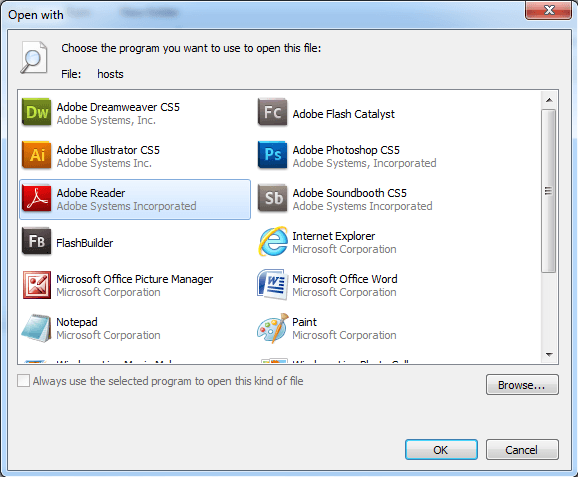
- How To Block Adobe From Internet Mac
- How To Block Adobe From Internet Browser
- How To Block Adobe Server
Launch the Edge browser, select Menu (the three dots running horizontally at the top-left corner of the browser) and go to Settings. Scroll down to ‘ view advanced settings ’ and click on it. On the slider next to ‘ Use Adobe Flash Player ’ toggle it to the ‘ Off ’ position. To force permissions: Click Gear icon to open settings tab, then go to Manage Add-ons Toolbars and Extensions Shockwave Flash Objec t. Right click Shockwave Flash Object, and select More. Here is how it works: First, start your task manager and kill the “AdobeUpdater.exe” process. Right click the new file “AdobeUpdater.exe”, select “Properties”, then “Security”. Mark at “Group or user names” “System”, press “Edit” and click on all “Deny” checkboxes. Now do this for all users. Go to Computer Configuration Administrative Templates Windows Components Internet Explorer Security Features Add-on Management. Double-click on 'Turn off Adobe Flash in Internet Explorer and prevent applications from using Internet Explorer technology to instantiate Flash objects'. Set the policy to 'Enabled'. Actually I do this, because currently I am using a trial version of adobe acrobat pro 10, and I am using an unpermitted serial number (crack). So each time the serial is detected immediately when I connect to the Internet.
Adobe Flash remains the one software that we all hate to need to run certain applications and perform certain tasks on our computers. That is because the software is notorious for having security holes that are constantly being patched to block hackers from driving an entire bus through them. In a nutshell, to stay secure with Flash installed on your computer, you need to constantly update the software.
Ironically, Microsoft natively integrated Flash in all the latest Windows OS so that its built-in browsers – Internet Explorer (IE) and Edge – can make use of it automatically. This approach makes sense from the perspective that Microsoft now remains in charge of the Adobe Flash updates. At the same time, IE and Edge will be able to accurately display Flash content right out of the box.
While it is all good and dandy that Microsoft takes charge of the Flash updates. The fact still remains that Flash remains quite porous, and new vulnerabilities are being discovered regularly; perhaps too regular. Adobe will continue releasing security patches to these vulnerabilities as and when they discover them.
However, now that Microsoft has put itself in charge of handling all Flash related matters on your computer. It means the end user no longer has control of these updates and will have to wait on Microsoft to effect the updates. The problem arises if the vulnerability discovered is severe, and Adobe released the update, yet Microsoft delayed on effecting the update installation on the user’s computer. Obviously, the users will just be sitting ducks, waiting for the hackers to do as they please.
How to disable Flash on Edge and IE
The thought of having security matters on your computer out of your own hands should scare you. Microsoft will most likely not feel the loss should a hacker exploit that window between when Adobe releases a patch and Microsoft effects the update.
Now that Windows comes built-in with Flash, it means you cannot uninstall the software, but good thing you can deactivate it on both the browser and the system tools.
How To Block Adobe From Internet Mac
Deactivating Flash in Microsoft Edge
Edge comes with built-in Flash support and has the option of turning it off. How you do that depends on the Windows version you are running. To check your version, click on WinKey + R
How To Block Adobe From Internet Browser
to open the CMD Prompt, then type WinVer and hit the
WinVer and hit the  Enter
Enter How To Block Adobe Server
 key.
key.For Windows 10 version 1803 and Earlier
Launch the Edge browser, select Menu (the three dots running horizontally at the top-left corner of the browser) and go to Settings. Scroll down to ‘view advanced settings’ and click on it. On the slider next to ‘Use Adobe Flash Player’ toggle it to the ‘Off’ position.
In the future, if you want to turn on Flash again, follow the same instruction and toggle the settings to ‘On.’
Windows version 1809 (October 2018 Update)
If you are running the very latest version of Windows 10, the Edge browser settings interface will be slightly different from those found in earlier versions. Launch the Edge browser > Settings > Advanced > Toggle ‘Use Adobe Flash Player’ to Off position.
Disabling Adobe Flash in the Group Policy (Admin privileges)
Administrators can go to ‘Allow Adobe Flash’ policy and deactivate Flash on all applications using it. FYI – the Group Policy Editor is only available to all Windows 10 versions except Windows 10 Home.
Click the Start button on your keyboard, and type gpedit.msc and click on the suggested ‘Microsoft Common Console Document.’ Doing so will start the Local Group Policy Editor.
Go to Computer Configuration > Administrative Templates > Windows Components > Microsoft Edge. Then double-click on ‘Allow Adobe Flash.’ You then need to set the policy to ‘disabled’ and click ok.
Disabling Adobe Flash in IE
You can also disable Adobe Flash support in IE, and any other application using the IE technology in the Group Policy Editor mentioned above. Go to the Group Policy Editor as aforementioned.
The go to Computer Configuration > Administrative Templates > Windows Components > Internet Explorer > Security Features > Add-on Management.
Then double-click on ‘Turn off Adobe Flash in Internet Explorer and prevent applications from using Internet Explorer technology to instantiate Flash objects.”
Then set the policy as ‘Enabled,’ and click Ok.0